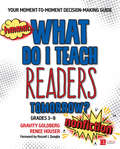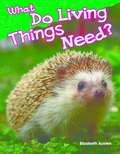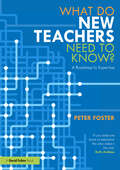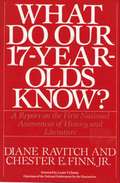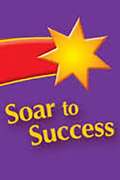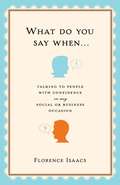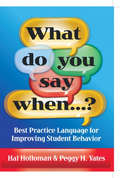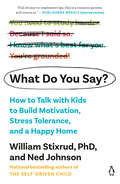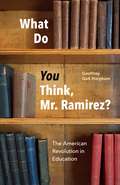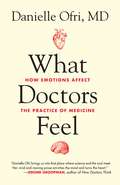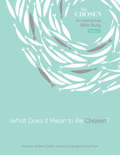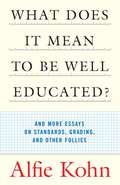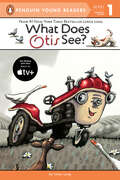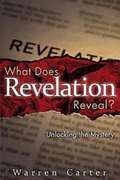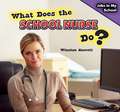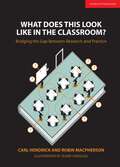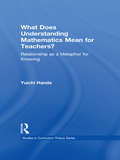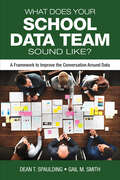- Table View
- List View
What Do I See?: Biblical Values (I Can Read! #Level 1)
by Crystal BowmanThis book introduces level-one readers to the sights and sounds of both country and city. The vivid and clever illustrations, along with the toe-tapping rhyme, help children experience God’s world in a fun way. From mooing cows to beeping cars, What Do I See? will hold the interest of young readers.
What Do I Teach Readers Tomorrow? Fiction, Grades 3-8: Your Moment-to-Moment Decision-Making Guide (Corwin Literacy)
by Gravity Goldberg Renee W. HouserStreamline formative assessment for readers in just minutes a day With What Do I Teach Readers Tomorrow? Fiction, discover how to move your readers forward with in-class, actionable formative assessment. The authors provide a proven, 4-step process—lean in, listen to what readers say, look at what they write, and assess where they need to go next. Next-step resources for whole-class, small-group, and one-on-one instruction, include Reproducible Clipboard Notes pages for quick assessments More than 30 lessons to get you started Reading notebook entries and sample classroom conversations Online video clips of Renee and Gravity teaching and debriefing
What Do I Teach Readers Tomorrow? Fiction, Grades 3-8: Your Moment-to-Moment Decision-Making Guide (Corwin Literacy)
by Gravity Goldberg Renee W. HouserStreamline formative assessment for readers in just minutes a day With What Do I Teach Readers Tomorrow? Fiction, discover how to move your readers forward with in-class, actionable formative assessment. The authors provide a proven, 4-step process—lean in, listen to what readers say, look at what they write, and assess where they need to go next. Next-step resources for whole-class, small-group, and one-on-one instruction, include Reproducible Clipboard Notes pages for quick assessments More than 30 lessons to get you started Reading notebook entries and sample classroom conversations Online video clips of Renee and Gravity teaching and debriefing
What Do I Teach Readers Tomorrow? Nonfiction, Grades 3-8: Your Moment-to-Moment Decision-Making Guide (Corwin Literacy)
by Gravity Goldberg Renee W. HouserStreamline formative assessment for readers in just minutes a day With What Do I Teach Readers Tomorrow? Nonfiction, discover how to move your readers forward with in-class, actionable formative assessment. The authors provide a proven, 4-step process—lean in, listen to what readers say, look at what they write, and assess where they need to go next. Next-step resources for whole-class, small-group, and one-on-one instruction, include Reproducible Clipboard Notes pages for quick assessments More than 30 lessons to get you started Reading notebook entries and sample classroom conversations Online video clips of Renee and Gravity teaching and debriefing
What Do I Teach Readers Tomorrow? Nonfiction, Grades 3-8: Your Moment-to-Moment Decision-Making Guide (Corwin Literacy)
by Gravity Goldberg Renee W. HouserStreamline formative assessment for readers in just minutes a day With What Do I Teach Readers Tomorrow? Nonfiction, discover how to move your readers forward with in-class, actionable formative assessment. The authors provide a proven, 4-step process—lean in, listen to what readers say, look at what they write, and assess where they need to go next. Next-step resources for whole-class, small-group, and one-on-one instruction, include Reproducible Clipboard Notes pages for quick assessments More than 30 lessons to get you started Reading notebook entries and sample classroom conversations Online video clips of Renee and Gravity teaching and debriefing
What Do Living Things Need? (Science Readers #Guided Reading Level B)
by Elizabeth AustenWhat do living things need to survive? Find out in this colorful science reader! Discover that living things need light, food, water, air, space, homes, protection, and more! The easy-to-read text and vibrant images will keep young readers engaged from start to finish. This reader also includes a fun science activity and practice problems to give students additional practice in sorting living and not living things. A helpful glossary and index are also included for support.
What Do New Teachers Need to Know?: A Roadmap to Expertise
by Peter FosterWhat knowledge will make you most effective as a teacher? New teachers are often bombarded with information about the concepts they should understand and the topics they should master. This indispensable book will help you navigate the research on curriculum, cognitive science, student data and more, providing clarity and key takeaways for those looking to grow their teaching expertise. What Do New Teachers Need to Know? explores the fundamentals of teacher expertise and draws upon contemporary research to offer the knowledge that will be most useful, the methods to retain that knowledge, and the ways expert teachers use it to solve problems. Written by an educator with extensive experience and understanding, each chapter answers a key question about teacher knowledge, including: • Does anyone agree on what makes great teaching? • How should I use evidence in my planning? • Why isn’t subject knowledge enough? • What should I know about my students? • How do experts make and break habits? • How can teachers think creatively whilst automating good habits? • What do we need to know about the curriculum? • How should Cognitive Load Theory affect our pedagogical decisions? Packed with case studies and interviews with new and training teachers alongside key takeaways for the classroom, this book is essential reading for early career teachers, those undertaking initial teacher training and current teachers looking to develop their expertise.
What Do Our 17-Year-Olds Know
by Diane RavitchWhat Do Our 17-Year-Olds Know? Gives the results of the first nationwide test of American high school students' knowledge of history and literature, as well as fascinating insight into what teenagers are reading, how much television they watch, what influence their home environment has on their academic achievement, and what historical topics and literary works are included in (or have been dropped from) the school curriculum.
What Do School Secretaries Do? (Jobs in My School Ser.)
by Rita KiddeSchool secretaries are organized, friendly, and dedicated, but many young students don't give them much thought. By reading more about school secretaries, students will come to better understand and appreciate the many ways these individuals ensure that their schools run smoothly.
What Do You Do When Something Wants To Eat You?: Soar To Success Student Book Level 3 Wk 8
by Steve JenkinsA hungry wolf's attempts to fatten a chicken for his stewpot have unexpected results. NIMAC-sourced textbook
What Do You Say When . . .: Talking to People with Confidence on Any Social or Business Occasion
by Florence IsaacsHave you ever walked alone into a room of chattering people and felt nervous? Is the idea of attending a wedding or job interview where you won't know many people intimidating? The art of conversation is a necessary skill for navigating life’s social and business occasions, and with practice you can develop the ability to easily talk to people. What Do You Say When ... is a smart, useful tool that helps you assess all situations and approach people with confidence.When you can chat easily and know the right things to say, you not only feel more relaxed, but also make others feel comfortable. What Do You Say When ... provides a complete guide to conversation in a variety of circumstances. It teaches the basics, plus helpful rules that work anywhere and with anyone—at cocktail parties, dinners, charity benefits, job interviews, conferences and conventions, dates, and even at family reunions and other gatherings. Also covered are can’t-fail conversation openers and strategies for expanding conversation and getting to know casual social or business contacts better. You’ll learn how to find appropriate words for difficult times, such as a friend’s divorce, illness, or job loss, or when someone’s loved one has died. Included, too, are tips on teaching your children to converse politely.Filled with examples, ideas, and practical advice, What Do You Say When ... helps you master one of life’s most essential skills.
What Do You Say When...?: Best Practice Language for Improving Student Behavior
by Hal Holloman Peggy YatesDo you remember a time when you used the right words at the right moment, and they made all the difference? With the aim of helping you repeat that experience every day, this book provides hundreds of examples of what we call “Best Practice Language” (BPL), a research-based technique designed to help teachers use words to improve student behavior – in the classroom and beyond. In their years of working at the K-12 levels, educators Hal Holloman and Peggy H. Yates have identified the exact phrases and key words you can use to handle: recurring disruptions, inappropriate outbursts, and students’ low self-confidence, among other classroom realities. BPL will enable you to: Set your expectations clearly on the first day of school Prevent and resolve conflicts between students Create a safe haven for shy, apprehensive students Establish meaningful relationships with students built on trust Help students foster a respect for themselves, their peers, and for adults Maintain a positive classroom environment that encourages personal responsibility Whether you're a new teacher, a veteran teacher, a pre-service teacher, or school administrator, the tools in this book will help you use words effectively, in ways that resonate with students and provide them with clear and promising direction.
What Do You Say?: How to Talk with Kids to Build Motivation, Stress Tolerance, and a Happy Home
by William Stixrud Ned JohnsonA guide to effectively communicating with teenagers by the bestselling authors of The Self-Driven ChildIf you're a parent, you've had a moment--maybe many of them--when you've thought, "How did that conversation go so badly?" At some point after the sixth grade, the same kid who asked "why" non-stop at age four suddenly stops talking to you. And the conversations that you wish you could have--ones fueled by your desire to see your kid not just safe and healthy, but passionately engaged--suddenly feel nearly impossible to execute. The good news is that effective communication can be cultivated, learned, and taught. And as you get better at this, so will your kids.William Stixrud, Ph.D., and Ned Johnson have 60 years combined experience talking to kids one-on-one, and the most common question they get when out speaking to parents and educators is: What do you say? While many adults understand the importance and power of the philosophies behind the books that dominate the parenting bestseller list, parents are often left wondering how to put those concepts into action. In What Do You Say?, Johnson and Stixrud show how to engage in respectful and effective dialogue, beginning with defining and demonstrating the basic principles of listening and speaking. Then they show new ways to handle specific, thorny topics of the sort that usually end in parent/kid standoffs: delivering constructive feedback to kids; discussing boundaries around technology; explaining sleep and their brains; the anxiety of current events; and family problem-solving. What Do You Say? is a manual and map that will immediately transform parents' ability to navigate complex terrain and train their minds and hearts to communicate ever more successfully.
What Do You Think, Mr. Ramirez?: The American Revolution in Education
by Geoffrey Galt HarphamGeoffrey Galt Harpham’s book takes its title from a telling anecdote. A few years ago Harpham met a Cuban immigrant on a college campus, who told of arriving, penniless and undocumented, in the 1960s and eventually earning a GED and making his way to a community college. In a literature course one day, the professor asked him, “Mr. Ramirez, what do you think?” The question, said Ramirez, changed his life because “it was the first time anyone had asked me that.” Realizing that his opinion had value set him on a course that led to his becoming a distinguished professor. That, says Harpham, was the midcentury promise of American education, the deep current of commitment and aspiration that undergirded the educational system that was built in the postwar years, and is under extended assault today. The United States was founded, he argues, on the idea that interpreting its foundational documents was the highest calling of opinion, and for a brief moment at midcentury, the country turned to English teachers as the people best positioned to train students to thrive as interpreters—which is to say as citizens of a democracy. Tracing the roots of that belief in the humanities through American history, Harpham builds a strong case that, even in very different contemporary circumstances, the emphasis on social and cultural knowledge that animated the midcentury university is a resource that we can, and should, draw on today.
What Doctors Feel
by Danielle OfriA look at the emotional side of medicine--the shame, fear, anger, anxiety, empathy, and even love that affect patient care Physicians are assumed to be objective, rational beings, easily able to detach as they guide patients and families through some of life's most challenging moments. But doctors' emotional responses to the life-and-death dramas of everyday practice have a profound impact on medical care. And while much has been written about the minds and methods of the medical professionals who save our lives, precious little has been said about their emotions. In What Doctors Feel, Dr. Danielle Ofri has taken on the task of dissecting the hidden emotional responses of doctors, and how these directly influence patients. How do the stresses of medical life--from paperwork to grueling hours to lawsuits to facing death--affect the medical care that doctors can offer their patients? Digging deep into the lives of doctors, Ofri examines the daunting range of emotions--shame, anger, empathy, frustration, hope, pride, occasionally despair, and sometimes even love--that permeate the contemporary doctor-patient connection. Drawing on scientific studies, including some surprising research, Dr. Danielle Ofri offers up an unflinching look at the impact of emotions on health care. With her renowned eye for dramatic detail, Dr. Ofri takes us into the swirling heart of patient care, telling stories of caregivers caught up and occasionally torn down by the whirlwind life of doctoring. She admits to the humiliation of an error that nearly killed one of her patients and her forever fear of making another. She mourns when a beloved patient is denied a heart transplant. She tells the riveting stories of an intern traumatized when she is forced to let a newborn die in her arms, and of a doctor whose daily glass of wine to handle the frustrations of the ER escalates into a destructive addiction. But doctors don't only feel fear, grief, and frustration. Ofri also reveals that doctors tell bad jokes about "toxic sock syndrome," cope through gallows humor, find hope in impossible situations, and surrender to ecstatic happiness when they triumph over illness. The stories here reveal the undeniable truth that emotions have a distinct effect on how doctors care for their patients. For both clinicians and patients, understanding what doctors feel can make all the difference in giving and getting the best medical care. Praise for Danielle Ofri "The world of patient and doctor exists in a special sacred space. Danielle Ofri brings us into that place where science and the soul meet. Her vivid and moving prose enriches the mind and turns the heart." --Jerome Groopman, author of How Doctors Think "Danielle Ofri is a finely gifted writer, a born storyteller as well as a born physician." --Oliver Sacks, author of Awakenings "Danielle Ofri ... is dogged, perceptive, unafraid, and willing to probe her own motives, as well as those of others. This is what it takes for a good physician to arrive at the truth, and these same qualities make her an essayist of the first order." --Abraham Verghese, author of Cutting for Stone "Danielle Ofri has so much to say about the remarkable intimacies between doctor and patient, about the bonds and the barriers, and above all about how doctors come to understand their powers and their limitations." --Perri Klass, MD, author of A Not Entirely Benign Procedure "Her writing tumbles forth with color and emotion. She demonstrates an ear for dialogue, a humility about the limits of her medical training, and an extraordinary capacity to be touched by human suffering." --Jan Gardner, Boston Globe From the Hardcover edition.
What Does It Mean to Be Chosen?: An Interactive Bible Study (The Chosen Bible Study Series #1)
by Amanda Jenkins Dallas Jenkins Dr. Douglas HuffmanThis is the official companion study to season 1 of The Chosen, the groundbreaking television series about the life of Jesus. What Does It Mean to Be Chosen? parallels each episode, connecting readers to the Bible in a brand-new way. It includes: A deeper look at Isaiah 43 and its fulfillment in Jesus and the lives of His followers (including us!)Script excerpts, quotes, and illustrations from the showGuiding questions for groups or individuals Being chosen by Jesus has beautiful and far-reaching implications—although it says even more about the Chooser than the choosees. We are loved because He&’s love. We are saved because He&’s merciful. We belong to the family of God because Jesus invites us, making the Bible and all its promises as true for us today as it was for God&’s chosen nation. What does it actually mean to be Chosen? To answer that question, we&’re going Old school—Testament that is—which leads us back to the New. Which always leads us directly to Jesus.
What Does It Mean to Be Well Educated?
by Alfie KohnKohn takes on the recent trend to stress grades and standardized testing in American schools. He compares getting an education to getting through the system, and finds that frustration and lack of real achievement grow in parallel when students are schooled rather than educated. The results, he believes, include a population more likely to be violent and less likely to think reasonably through issues and situations. Annotation ©2004 Book News, Inc. , Portland, OR (booknews. com)
What Does Otis See? (Otis)
by Loren LongWatch Get Rolling with Otis on Apple TV!Featuring the New York Times bestselling character Otis! Join Otis as he explores the many fun things there are to see on the farm! In this new leveled reader, Otis sees a puppy, a little calf, and even a bull. Kids will love learning to read with one of their favorite characters, Otis the tractor!
What Does Revelation Reveal?: Unlocking the Mystery
by Warren CarterThe Book of Revelation has been mysterious, confusing, and misunderstood for centuries. Its content has been studied and analyzed by scholars from every corner of the globe. What is it about Revelation that draws us to it? Is this biblical book about end-time mysteries and hidden codes? Does and it relate to our present day? So what does Revelation actually reveal? Or should Revelation be left behind? According to Dr. Carter, the book of Revelation can tell us about biblical times as well as our own. It can show us how we, as Christians, are to live and hope for our world. Revelation reveals God's Word to God's World: that culture accommodation is dangerous, that judgment is taking place now, that the world does have a chance to repent, that there are evil powers working behind the scene, that the time is up for the eternal empire, and that God is coming in triumph.
What Does The School Nurse Do? (Jobs in My School Ser.)
by Winston GarrettFrom treating stomachaches to cuts or even worse, the school nurse makes sure students remain well, safe, and happy. Early readers will take a closer look at this vital job, and, in doing so, overcome any anxiety that may have when visiting the school nurse.
What Does This Look Like in the Classroom?: Bridging the gap between research and practice
by Robin Macpherson Carl HendrickEducators in the UK and around the world are uniting behind the need for the profession to have access to more high-quality research and evidence to do their job more effectively. But every year thousands of research papers are published, some of which contradict each other. How can busy teachers know which research is worth investing time in reading and understanding? And how easily is that academic research translated into excellent practice in the classroom In this thorough, enlightening and comprehensive book, Carl Hendrick and Robin Macpherson ask 18 of today's leading educational thinkers to distill the most up-to-date research into effective classroom practice in 10 of the most important areas of teaching.The result is a fascinating manual that will benefit every single teacher in every single school, in all four corners of the globe.
What Does This Look Like in the Classroom?: Bridging the gap between research and practice
by Robin Macpherson Carl HendrickEducators in the UK and around the world are uniting behind the need for the profession to have access to more high-quality research and evidence to do their job more effectively. But every year thousands of research papers are published, some of which contradict each other. How can busy teachers know which research is worth investing time in reading and understanding? And how easily is that academic research translated into excellent practice in the classroom In this thorough, enlightening and comprehensive book, Carl Hendrick and Robin Macpherson ask 18 of today's leading educational thinkers to distill the most up-to-date research into effective classroom practice in 10 of the most important areas of teaching.The result is a fascinating manual that will benefit every single teacher in every single school, in all four corners of the globe.
What Does Understanding Mathematics Mean for Teachers?: Relationship as a Metaphor for Knowing (Studies in Curriculum Theory Series)
by Yuichi HandaThis book opens up alternative ways of thinking and talking about ways in which a person can "know" a subject (in this case, mathematics), leading to a reconsideration of what it may mean to be a teacher of that subject. In a number of European languages, a distinction is made in ways of knowing that in the English language is collapsed into the singular word know. In French, for example, to know in the savoir sense is to know things, facts, names, how and why things work, and so on, whereas to know in the connaître sense is to know a person, a place, or even a thing—namely, an other— in such a way that one is familiar with, or in relationship with this other. Primarily through phenomenological reflection with a touch of empirical input, this book fleshes out an image for what a person’s connaître knowing of mathematics might mean, turning to mathematics teachers and teacher educators to help clarify this image.
What Does Your School Data Team Sound Like?: A Framework to Improve the Conversation Around Data
by Dr Dean T. Spaulding Ms Gail M. SmithInspire the data discussion! Data is a valuable resource for improving education. Unfortunately, many school data teams struggle to make sense of new and often overwhelming data. What Does Your Data Team Sound Like? provides an approach that gets teams talking about and applying data effectively in a variety of setting and scenarios. Written to help data teams navigate the confusing world of data analysis for on-going school improvement, this book offers a framework that is rigorous yet easy to follow. Readers will find: Easy, step-by-step discussion & analysis techniques Case studies that demonstrate different approaches Checklists and flowcharts to help visual the process


